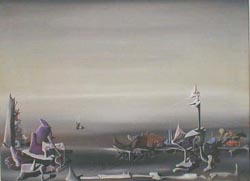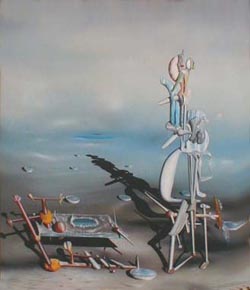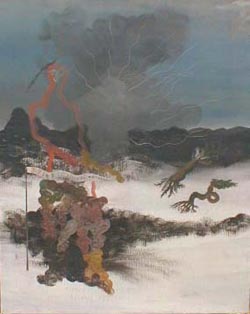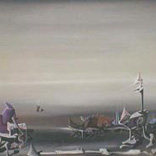As the first paragraph of the Menil’s brochure mentions, Tanguy’s paintings have been criticized for their uniformity.
OK, it’s true; after 1933 they’re all more or less the same. So what? It’s only a problem if you hang a room full of them together. Tanguy’s work is unusually consistent, but consistently good; his later blobs are as intricate and curious as his first ones. There are not many duds in the show, just a surfeit of very similar, very odd paintings, any one of which would look fine alone.
Tanguy was self-taught, and after his initial cubist experiments spent a couple of interesting years playing with paint texture and technique before settling down to the rocks-on-a-lonely-beach compositions which make up most of the show. In 1927-29, Tanguy had discovered painting but had not yet mastered it, experimenting with a rich vocabulary of abstract illusionist techniques that he mostly dropped in his later work. Restless, unselfconscious experiments with scrubbing, scratching, dripping and rubbing produced Tanguy’s best paintings. In On Sonne (Someone is Ringing), squiggly brushstrokes do double duty as a pair of woolly legs and the trunks of windswept trees. In the background, thin white lines scratched into a scrubbed-in gray cloud wave like microscopic cilia. Dry-brushed smudges become vapors, storms and ghosts. Scratched-in lines are whiskers, cobwebs or radiations.
After 1933, Tanguy settles into his signature formula: creating endless gloomy landscapes and populating them with Bosch-like crowds of bizarre mental furniture. Dirty, dreary and flaccid (I mean this in a good way), Tanguy’s later paintings partake of the common surrealist pathos — the conviction that the subconscious is a dark, perverted place, populated by monsters. Within the superficially similar framework of each painting lies an abstract, mechanistic soap opera, crowded with the unique characters and situations that were Tanguy’s main interest. Some blobs are heroic, some comic, elegant, disfigured, or pathetic. Some are animal, some vegetable, some mineral.
Divisibilité Indéfinie from 1942 is one of the more overtly figurative: two groupings of bonelike biomorphs might suggest the artist at his easel (or a hundred other situations). Tanguy’s microscopic vision focuses exclusively on the details of his little rock formations, orchestrating their shapes and interconnections with the hermetic intensity of a child assembling Tinkertoys.
All images courtesy The Menil Collection.
Bill Davenport is an artist and writer and was one of the first contributors to Glasstire.







